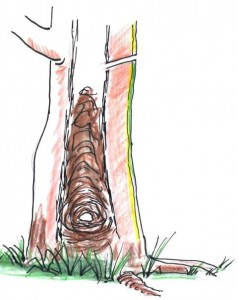Termites with visible nests in trees do not often pose a critical threat to homeowners.
Termites that build mounds are often just grass and leaf-litter feeders but some mound builders are very interested in the solid, seasoned timber in houses.
It makes no sense to allow any termite mounds to be anywhere within a hundred meters of your home and outbuildings in case they are seriously interested in timber instead of just dead grass.
Learn About Our Solution Finder
How to Kill Termites in Trees
The brown nests seen high up in the branches contain termites feeding on the moist and rotting wood in the hollow inside the trunk and the tunnels down the outside of the trunk are for access to the leaf litter and surrounding grass. Breaking off these tunnels every time they reform should eventually starve the colony to death and often birds such as kingfishers or parrots will convert the mound mass to a very comfortable avian nest.
The other type of tree nest is serious.
You should check large trees near your house for termites in the pipe or hollow trunk. Any large, old trees such as fruit trees, peppercorns and Eucalyptus are typically hollow and provide a termite nest site that ticks all their boxes: food, moisture and protection.
To test if termites are ‘at home’ you can use an auger to drill into the centre at about chest height and inspect for termites. If there is a hollow, you will feel a lessening of resistance once you reach it. Sometimes you will see termites in the fluting of the auger bit as you withdraw it or if you insert a long piece of grass into the hole and withdraw slowly.
If there is a hollow but no termites can be seen, return to the opening the next morning to see if termites have repaired the hole. If it has been repaired it is because termites are definitely in there. Killing the colony inside is then a simple matter of reopening the hole and pouring 20 to 30 litres of chlorpyrifos or a bifenthrin solution into the trunk.
How to Kill Termites in Mounds
Use a crowbar or a pick to break open the top and sides of a mound.
The royal chamber and the surrounding nursery are low down in the centre of the mound. The thousands of exposed termites die quickly from dehydration (and the ants which seem to appear from nowhere.) If your physical destruction has not been enough, you will see signs of rebuilding within a couple of days.
You can either have another go with your implements or use 20 to 30 litres of the dilute insecticidal compound as used to destroy termites in the trunk of a tree.



Hi,
I have found termites in my fathers house they are just starting to get into the floor boards the species is coptos we found and detroyed 3 mound type nests in the ground on average about 50 metres away from the house if it was one of these nests atacking the house how long would the termites remain in the house before they die out after destroying the nest ? Thank-You Victor